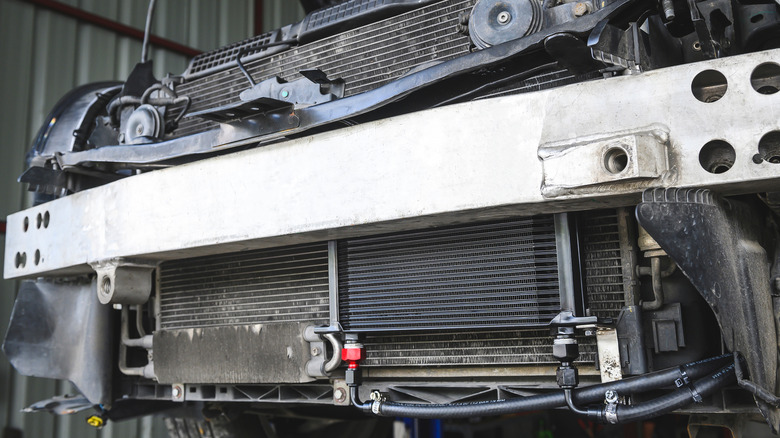What Does A Transmission Cooler Do And Do You Really Need One?
Much like an engine, bad habits can accumulate and start to harm your transmission, which is one of the most important systems in your car or truck. Of course, there are certain things you can do to extend the life of your vehicle's transmission, including making sure your car has the transmission cooler it needs.
Ideally, you want to keep transmission fluid below 200 degrees Fahrenheit because higher temperatures can greatly reduce the effective lifetime of the fluid. In general, the cooler you keep your fluid, the longer your transmission should be able to last. The best way to do that is by making sure your transmission is operating as it should and changing your car's transmission fluid. You might also consider installing a transmission cooler.
But what exactly is a transmission cooler? And is the money and effort required to put one in your vehicle really worth it? The answer is a resounding "sort of," though really it all comes down to your personal car or truck.
What are transmission coolers?
Just like the name implies, transmission coolers are designed to cool a vehicle's transmission. More specifically, they cool down the transmission fluid before it goes back into the system — thus keeping temperatures down and helping to prevent overheating.
Tube and fin coolers are generally the most affordable option but they're also less efficient than the other two primary designs. Plate and fin coolers are more efficient than the tube variety because they cool more liquid overall, although they do cost more. Stacked plate coolers round out the trio as the most efficient and most expensive option.
If you do decide to shop around for transmission coolers, bear these different types in mind. You can't really overdo it when it comes to cooler capacity, but if you use your car to go to work and other everyday activities, the most costly stacked plate models won't be necessary. Those are more geared toward heavy vehicles or commercial drivers who operate their vehicles in extreme conditions. Additionally, the actual dimensions of the cooler and available space around your transmission should be taken into account.
How necessary is a transmission cooler?
Whether or not you "need" to install a transmission cooler in your vehicle depends on how much strain you put on it, as well as the types of environments you do most of your driving in. For the average driver, it's more of a potentially useful addition than a vital piece of equipment.
That being said, a properly installed transmission cooler will be especially handy when you're driving around in extreme heat, towing or hauling heavy objects, moving over the kind of terrain that requires more "oomph" from the engine, or even when stuck in stop-and-go traffic situations. Basically, any time your vehicle's transmission is working hard enough to heat up the transmission fluid, having a cooler will help.
Installing a transmission cooler can also get a bit pricey, costing hundreds of dollars for just the parts. Factor in labor, and it could run you anywhere between $600 to more than $1,000 – depending on the garage, the vehicle, and which cooler you choose.


